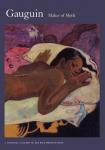 |
|
|||||||||||||||||||||||||||||||||||||||||||||||||||||||||||||
 Paul Gauguin was a strange guy who spent his life in search of paradise, which he tacitly but clearly recognized as an illusion. For over a hundred years he's been considered one of the most important of the French post-impressionist painters but, in his own time, he was a commercial failure. Paul Gauguin was a strange guy who spent his life in search of paradise, which he tacitly but clearly recognized as an illusion. For over a hundred years he's been considered one of the most important of the French post-impressionist painters but, in his own time, he was a commercial failure. The predominant subtext of the short film Gauguin: Maker of Myth This lovely short film, produced by the National Gallery of Art, is a vivid and concise introduction to the artistic career of the pivotal and influential Gauguin. Oddly, though, no director or writer is credited; distressing, that. The film is edited by the talented and keen-eyed John Warnock (the photographer, not the CEO of Adobe who announced Photoshop in 1987--unless I'm deeply confused, of course, and the universe is in fact running in a course deeply in tune with the desires of mortal humans). Also not credited is the, so to speak, book of the exhibit (And if the Tea Partiers hold against the federal or any other bureaucracy the fact that the creative origins of this film are lost in the mists of history or otherwise obscured by internal politics, I shall, as a respected and publicly valued member of aforesaid bureaucracy, personally diminish them each and every one with a savage pea-shooter pleasure, for we are, after all, engaged in a culture war, and therefore far be it from me to shirk my body count, and far be it from me to dismiss as redundant to the free-market productions which, on no accounting, should in fact be funded by, regardless of profit to, capitalists [except, perhaps, and only once the glass ceiling is once and truly broken, upon the whim of post-menstrual might-have-been CEOs in search of a write-off] demanding filmic profit and who are last-of-all interested in neither your welfare nor your education. Partisanship aside, folks, we simply wouldn't have info-images [narrated by that sexy homo William Defoe!] like these unless we all band together as a nation or... Goddess forbid, depend on the Europeans to tell us what's good.) Gauguin wasn't always a painter. He worked the first part of his career as a stockbroker, and apparently stoked up a pot of money. He was good enough at it, in any case, that he started collecting art (and banged out five kids with the wife he later dumped for the savage life). In the 1870s, though, he left all that to take up painting. In those days, paintings were like guitars, and you could lose your man to some muse, some passion other than you. Maker of Myth Gauguin went to Tahiti in the late 1800s in search of paradise but, if it had ever been there, it was long gone by the time he arrived. Tahiti was a French colony, ravaged by European diseases, its native proclivities dumbed down by the plague of Christianity spread by its myrmidons, the missionaries. So, like he did with the rest of his life in images, he invented the Tahiti he wanted to see. He drew on a memory enhanced by engravings and that all-new-thing, photography; Gauguin's "post-impressionism" made him one of the planet's first global mash-up artists. Kudos to this 28-minute film for emphasizing the encircling musculature of influences shaping Gauguin's art. I have a small quibble with the film's biographical verisimilitude. Contrary to the film's narrative arc, Gauguin's guises were not always invented out of whole cloth. Gauguin wrote that he was born an Incan (and a savage one, at that), a claim that is, to be sure, not strictly true. However, the film leads us to believe that he only hooked up with this idea after a visit to Peru as an adult. In fact, his mother was Peruvian (and therefore no doubt mestizo and thus quite possibly a descendent of Incans) and the family of pater familias Clovis Gauguin lived in Peru for four years when Paul was yet but small and highly formative. Indeed, his mother was a proto-feminist, at least according to one or another wave of sources, while both his parents were for sure and for their time of a socialist inclination, thus lending context to the artist's later distaste for the hustle and bustle of capitalism, its blatant exploitation of self and other, and Gauguin's consistent portrayal of women as the interrogators of his paintings' mises en scenes. Except, that is, when they weren't, in which case he was painting a self-portrait. It seems that his picturative fictions of self are what engaged his avant grade and early adherents, while it was his exotic nudes that claimed fame for his work in the long run. It's good, once and a while, to think of a Gauguin bigger than all that. Even as his reputation back in France began to expand and his paintings began to sell, Gauguin grew even wearier of the so-called civilization he had left behind. Perhaps deeply depressed about the illusion of paradise, perhaps crushed by the exhausting stress of poverty, from Tahiti he fled to an island deep in the Polynesian outback of the Marquesas chain. The film says he wanted to be alone, but let us note that in his travels Gauguin always, in the parlance used in this production, took a local "girl as a lover." Artistic solitude, apparently, is all relative. In any case, his final years were highly productive ("feverish") and we all, on the other side of some sort of great divide separating us from paradise or anything but the most technical of adventures (all now prerequisite upon in-advance shopping adventures), can only look back in wonder at the thoughts he must have thought in a cultural milieu so different from ours that we, now, hardly recognize its anonymity and mobile poverty as our own. Gauguin died just before his 54th birthday. He was buried and is now enshrined by his market--the lovers of his art and the economic power they wield--on that distant island in the south Pacific. |
|
|||||||||||||||||||||||||||||||||||||||||||||||||||||||||||||
|
||||||||||||||||||||||||||||||||||||||||||||||||||||||||||||||
| action | animation | art house/international | comedy | documentary | drama | family | horror/sci-fi | suspense | television | ||||||||||||||||||||||||||||||||||||||||||||||||||||||||||||||
| contact | home | ||||||||||||||||||||||||||||||||||||||||||||||||||||||||||||||


